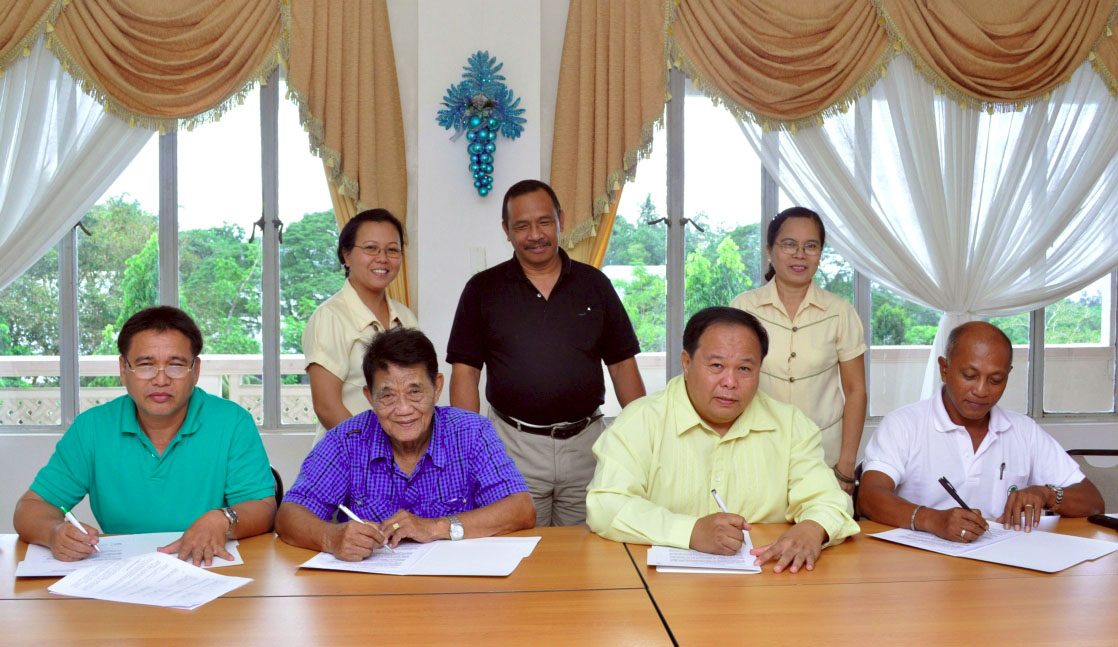MOA for the protection of water resource and biodiversity conservation in Silago signed
- Details
- Written by JFMBaldos
-
Published: 09 February 2012

The Memorandum of Agreement (MOA) for the establishment of a Long Term Ecological Research (LTER) in Barangay Catmon, Silago, Southern Leyte that will look into the preservation and protection of the watershed, increase water production and improvement of water quality, and biodiversity conservation in Barangay Catmon (where the project will be established) was signed on January 17, 2012 at the VSU Office of the President. The MOA between the Visayas State University, Municipality of Silago in Southern Leyte, Department of Environment and Natural Resources (DENR) through the Community Environment and Natural Resources Office (CENRO) in San Juan, So. Leyte, and Barangay Catmon in Silago, was signed by Dr. Jose L. Bacusmo, Hon. Manuel A. Labrador Sr., Forester Alejandro K. Bautista, and Mr. Alipio L. Dadap, Barangay Captain of Catmon, Silago, So. Leyte, respectively.
Other signatories of the MOA were: Dr. Maria Juliet C. Ceniza, Dean of VSU's College of Forestry and Natural Resources (CFNR) and Director of the Institute of Tropical Ecology (ITE), and For. Joejol M. Cuizon, Forester III of DENR-San Juan, So. Leyte, in the presence of Dr. Renezita S. Come, Project Component Leader and Asst. Prof. of CFNR, and For. Ricardo T. Tomol, PENRO-Southern Leyte.
The MOA signing signified the parties' commitment and involvement in implementing environment and rural development initiatives and enhancing all possible areas for collaboration between and among them leading towards protecting, rehabilitating and preserving lowland dipterocarp forests in Silago.
VSU, in its part, shall provide technical assistance on the promotion of sustainable forest development; protect and conserve biodiversity; craft forest protection policy and institutional strengthening; and establish LTER plots through community organizing, capability building activities, expert advice and regular field visits.
All expenses related to the establishment of LTER plots will be shouldered by the University through the project entitled "Community-based Forest Restoration and Biodiversity Protection and Management of Lowland Dipterocarp Forests in Silago, Southern Leyte" funded by the Philippine Tropical Forest Conservation Foundation (PTFCF).
DENR, on the other hand, shall provide a 50-hectare area in a natural forest in Silago, So. Leyte for the establishment of the LTER plots under the protection and management by the concerned stakeholders for a period of 25 years and renewable for another 25 years. It will also assist and participate in forest protection, restoration and biodiversity conservation; designate or appoint an Action Officer whose function, among others, is to serve as focal person in the establishment of the LTER;
Collaborate and work together with VSU regarding forest development, restoration, and improvement of LTER and scientific analysis during the investigation or research within the site; facilitate the deputation of Bantay Gubat in the Barangay Local Government Units (BLGUs) and Municipal Task Force; and provide technical assistance in the conduct of para-legal training to the Municipal Task Force and BLGUs to enhance capacity building.
The LGU-Silago shall assist Brgy. Catmon in forest protection, restoration and biodiversity conservation by providing logistical and manpower supports (i.e., Municipal Task Force); designate or appoint an action officer whose function, among others, is to serve as focal person in the implementation of the LTER plots; and legislate municipal ordinance substantial to the protection and conservation of the lowland dipterocarp forests in Silago.
Moreover, Barangay Catmon shall help in safeguarding the LTER through regular patrolling from any illegal activities that may disturb the on-going research activities in the site and legislate ordinances which are substantial to the protection and conservation of the intact forests within their vicinity.
This initiative was conceptualized by VSU's Institute of Tropical Ecology under the leadership of Dr. Maria Juliet C. Ceniza for fear of losing biodiversity brought about by many pressing factors such as deforestation, land use change, and other human activities in the area. Dr. Ceniza also emphasized that climate change may also exacerbate the situation leading to extinction of many important species.

